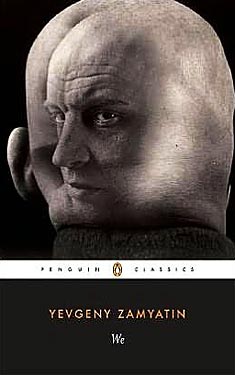Yevgeny Zamyatin
Completed 3/7/2016, reviewed 3/8/2016
3 stars
“We” is the root of the modern dystopian novel. It was the inspiration for “1984”. It was written in 1921, only a few years
after the Russian Revolution, and it was already predicting life under
Stalinism. The story is about the
designer of the spacecraft, the Integral,
which will carry the message of the “One State” to the universe. The designer, D-503, is the perfect citizen
of the “One State” until he meets and falls in love with the subversive
I-330. Through her, his precise model
world slowly unravels and he discovers to his horror that he has a soul and
that life is messy. It’s a good book,
but a tough read.
 What makes this book a tough read is that it is written
almost in stream of consciousness style.
The premise is that this is the journal of D-503. He is writing it as a document of life in the
“One State” for the otherworldly beings the Integral
may come into contact with. Being a
believer in the truth, he writes down everything, including non-sequitors and
partial thoughts. This makes it hard to
follow, but gives you the feeling that you are actually in the character’s
head.
What makes this book a tough read is that it is written
almost in stream of consciousness style.
The premise is that this is the journal of D-503. He is writing it as a document of life in the
“One State” for the otherworldly beings the Integral
may come into contact with. Being a
believer in the truth, he writes down everything, including non-sequitors and
partial thoughts. This makes it hard to
follow, but gives you the feeling that you are actually in the character’s
head.
Zamyatin’s writing style includes a lot of color to describe
things. He constantly refers to things
and people and parts of the body with colors, particularly he uses pink a
lot. It’s been noted that Zamyatin may
have had a condition known as synesthesis, in which he attributes qualities to
letters and sounds, particularly colors.
That may be why he referred to the character I-330 as pink so very often.
This book is very soft SF, that is, it deals more with the
social sciences than it does with technology and hard science. People are referred to as numbers. Hence the characters are D-503, I-330,
etc. People live in glass apartments so
that they can be observed at all times.
The only time they are allowed privacy is when they have their scheduled
times for sex. And sex is interesting as
well. There is no more marriage. People present each other with pink cards
indicating that they want to have a sexual encounter. It’s all very logical and ordered.
I can’t help but make the comparison to the adage that
people who live in glass houses shouldn’t throw stones. While not a direct analogy, I-330 is D-503’s
stone. When she comes into his life, his
world-view shatters and he realizes he has a soul. He compares it to the mathematical number “i”
or the square root of negative one. It’s
an imaginary number that threw him into disarray in school, as does I-330 in
his life now. It eventually leads him to
the Green Wall, a wall that surrounds the One State, which locks out the rest
of the world. Outside this wall are
plants, animals, birds, and the humans who were left out after the
revolution.
There is a lot of imagination in this story, which makes it
very interesting. It’s just the form and
the odd adjectives that makes it very tough to read. I give this book three out of five stars. It’s also important to remember that this
books was translated from the Russian. I
have not read a lot of Russian literature, but I whenever I have, I’ve found it
difficult.
No comments:
Post a Comment